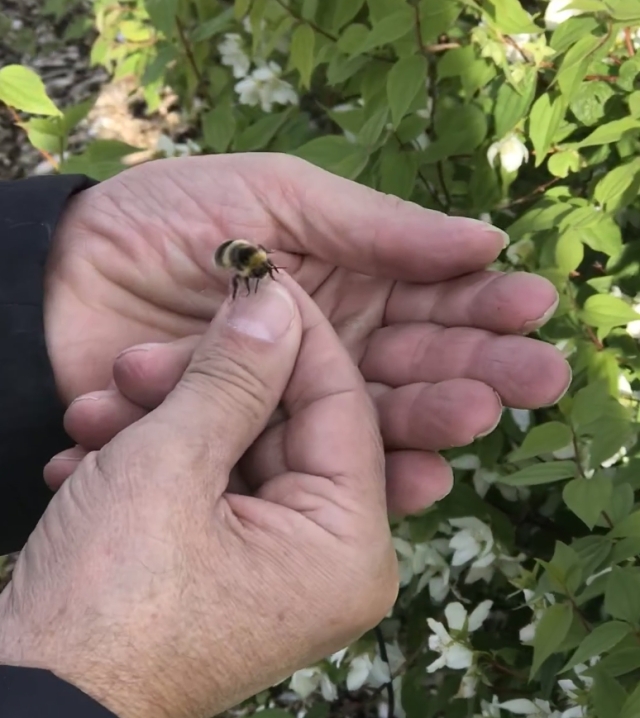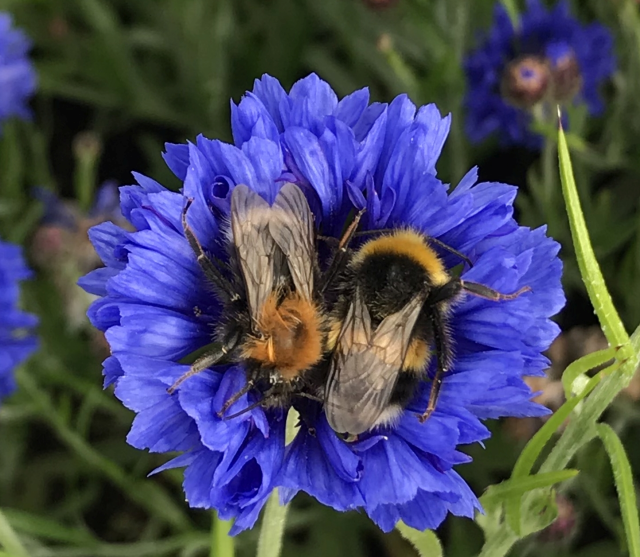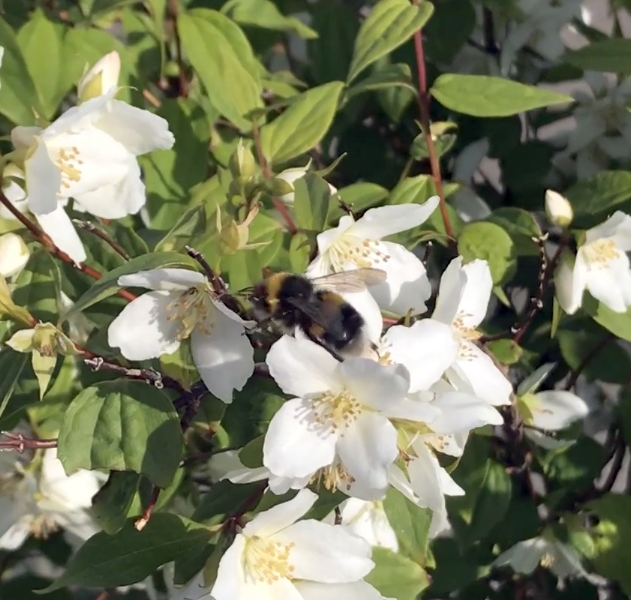
I’m holding this Icelandic bumblebee so I can slip an RFID tag on her front left leg (if she’s right-handed; use the right leg for left-handed bees). It’s similar to tagging a passenger pigeon.
(Actually, I just wanted to get a closer look.)
So much has happened in the weeks since my last post: I started an MSc (in bee ecology); my son and I pulled our honey crop; I presented a talk at the first-ever United Beekeepers of Alberta conference; I began to TA (teach) a university computer lab on statistical biology; I wrote a feature about the late Warwick Kerr (see it in the November 2018 American Bee Journal); we winterized our hives; and, I had almost three hours of sleep. I will write posts on some of these things in the future, but first I have to keep a promise.
Back in August, when I returned to Calgary from Iceland, I said that my next post would be about the bees I saw in Iceland. It wasn’t. Dr Warwick Kerr (“The Man Who Created Killer Bees”) died in early September, so I posted about him instead. Writing about Kerr became a priority (When was the last time a country lowered its flags because a bee research scientist died?). My posts about Kerr led to my American Bee Journal article which needed written within a few days to meet the journal’s publishing deadline.
I was in Iceland in late August. Previously, I posted a bit about beekeeping there. Honey bees are scarce in the Viking Republic. A few beekeepers try to keep a few hives, nursing them along through months of cold snowy darkness and then feeding the bees to prevent starvation if the summer is cold and wet – as it was this year. I visited Iceland in late summer when honey bees should have been foraging. They would normally collect some honeydew from small trees and bushes at that time, but this year, they didn’t. It was a disaster for honey bees, as might be expected during the coldest Icelandic summer in 100 years.
It was too cold for honey bees. However, I saw bumblebees. Big, fat, bumbling insects that took wing by the thousands when the weather improved. After days of intermittent showers and temperatures around 10C (50F) the sky cleared and Reykjavikians pulled off sweaters and faced the sun, like prairie gophers on a mild winter day. Or bumblebees on a sunny day in Iceland.

Ever seen two bees sleeping in a flower?
The sight of two bumblebees sharing a flower was definitely a Kodak moment. This was the first time that I’d seen such a sight. It had been cool and wet. These bumblebees snuggled in the rain. Then the sun came out. It became bright and almost warm. The bees began to dry. Within minutes, they revived from motionless to twitching to shaking as their muscles generated heat. Then they flew off.
Bumblebees lived in Iceland long before people arrived 1200 years ago. They adapted to Iceland’s flowers and the flowers adapted further to attract bumblebees. Honey bees, on the other hand, are not native to Iceland. They only survive when kept by humans and will surely die out when the people of Iceland all move away. In Iceland, honey bees need to be kept, making Icelandic enthusiasts true bee ‘keepers’.
Bumblebees survive the long winters when solitary queens find dens and burrows to slumber through the cold in a dormant state, patiently awaiting mild weather. When it comes, they rapidly build nests, populate them with a few hundred bees, and pollinate the native flowers of Iceland. In late summer, a few females mate and then find solitary dens and burrows to once again slumber until the coming spring’s mild weather. And so it goes.
I was lucky to meet so many nice Icelandic bumblebees. Here are some of them:

Reykjavik, Iceland’s capital, is full of bees.






Lovely to see those sleeping bees. Congratulations on doing so many things!
LikeLiked by 2 people
My favourite picture is the photo of the sleeping bees. I was in Iceland with my teenagers. (My wife was left in Calgary working.) My sister from San Diego met us in Reykjavik and she took that picture.
I am doing more than I should be doing – hope that I don’t win the Darwin Award! (Given to the person who successfully dumbs himself to death.)
LikeLike
Seconding Emily: ). Any possibility of ID’s on these Icelandic blossoms, Ron? One looks very much like lilac, but not its leaves and the Centaurea are spectacular!
LikeLiked by 1 person
Thanks, Deb! I don’t know the flowers – except there was honeysuckle in a couple photos and the lilac-looking flower was not lilac. Sorry that I can’t be more precise. You will have to go to Iceland and find out!
LikeLike
Yeah, right! I’ll let you know if I happen to find out…
LikeLike
Great pictures. Thank you for sharing those.
LikeLiked by 1 person
Thanks for the post, Ron, and the great pictures. Do you know of any relationship between the Bombus frigidus species found in North America (Alaska and Canada) and the Icelandic bumblebee species? I did a quick check and it appears the bumblebees in Iceland are a different species. I assume they are both cold-weather adapted, so am curious. Thanks again.
LikeLiked by 1 person
Hi Erik,
I have been trying to find out the same thing you’ve asked.
From a public domain ResearchGate paper:
“An ecological study of the species in 1979 revealed the presence of B. hortorum (L.), B. lucorum (L.) and B. jonellus. B. hortorum was found in the Rekjavik area in habitats supporting introduced flowers, and was unrepresented prior to 1959 in collections dating back to 1913. B. hortorum has probably become established since the 1950’s, and B. lucorum may also be a recent introduction.”
Doesn’t quite answer the question, but sure reduces the number of bee options!
LikeLiked by 1 person
Yes, thank you. Wikipedia says the genus Bombus had 49 subgenus, which makes me wonder how it all fits together. The site says B. frigidus and B. jonellus are both in the Pyrobombus subgenus, so perhaps there is a known relation somehow. I will look forward to another post if you get the gory details.
Thanks again!
LikeLike
What a delightful post. I am always amazed at bumblebees, they seem a lot less picky than honey bees, and I so enjoy seeing the flower beds and wildflowers fields I have help build being used. Like the pictures.
I have an interesting question, what is the lineage of the Icelandic honey bees? I know that in UK there is a native strain that is more conservative in its habits such as apis mellifera mellifera? (Youtube: Honey Bees in the Wild – PART 1 – What can we learn from them? by Roger Patterson Time: 8 minutes ).
I saw a lot of dark bees on my last trip to Europe, post to follow.
Thank you for the interesting post.
LikeLiked by 1 person
May I ask what you spoke about at the Alberta Bee conference? At our next beee club meeting we’re being asked for ‘who we would like to speak’ at the next BC. Bee conference which is being held in Prince George next year (October I think, but don’t quote me on that).
LikeLike
Hi!
My talk at the United Beekeepers of Alberta was about Alberta beekeeping (climate/government/history/flora/etc) but last year I presented a talk which I called “The World’s Sweetest Honey” which had a really nice reception. I covered things which beekeepers should know, but usually don’t – why does honey vary in colour, flavour, and sweetness, and what’s the sweetest honey in the world? I described the different sugars in honey (fructose, glucose, maltose, sucrose, etc) their varying sweetness, and also talked a bit about granulation (and how to control it). It turned out to be a honey of a talk!
Ron
LikeLiked by 1 person
(I have sent you a PM via email.)
LikeLike
Sorry, I didn’t see your second message 🙂
LikeLike
Thank you – I’m going to pass that along at the meeting. Is there a particular way to contact you in regards to scheduling or fees should there be interest in having you come to speak?
LikeLike
Hey Ron, the lilac that isn’t is actually a Buddleia (aka Butterfly Bush; )
LikeLiked by 1 person
Thanks! I’m glad you figured it out for us. I only knew for ‘certain’ that it wasn’t a lilac – now we know that it’s the Butterfly Bush.
LikeLiked by 1 person
Pingback: A Year of Backyard Beekeeping | Bad Beekeeping Blog
Pingback: Hot Bee Topics in 2018 | Bad Beekeeping Blog